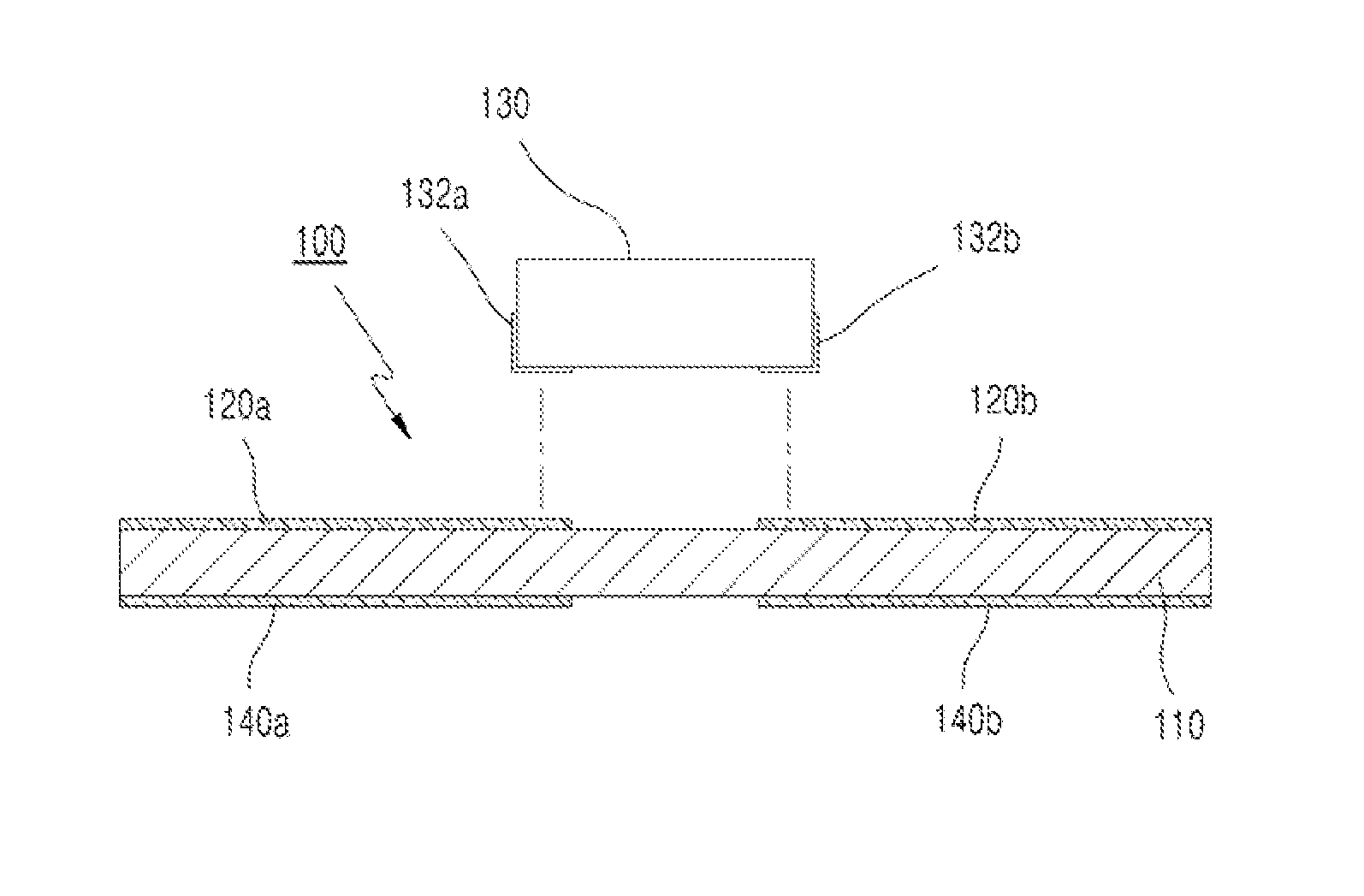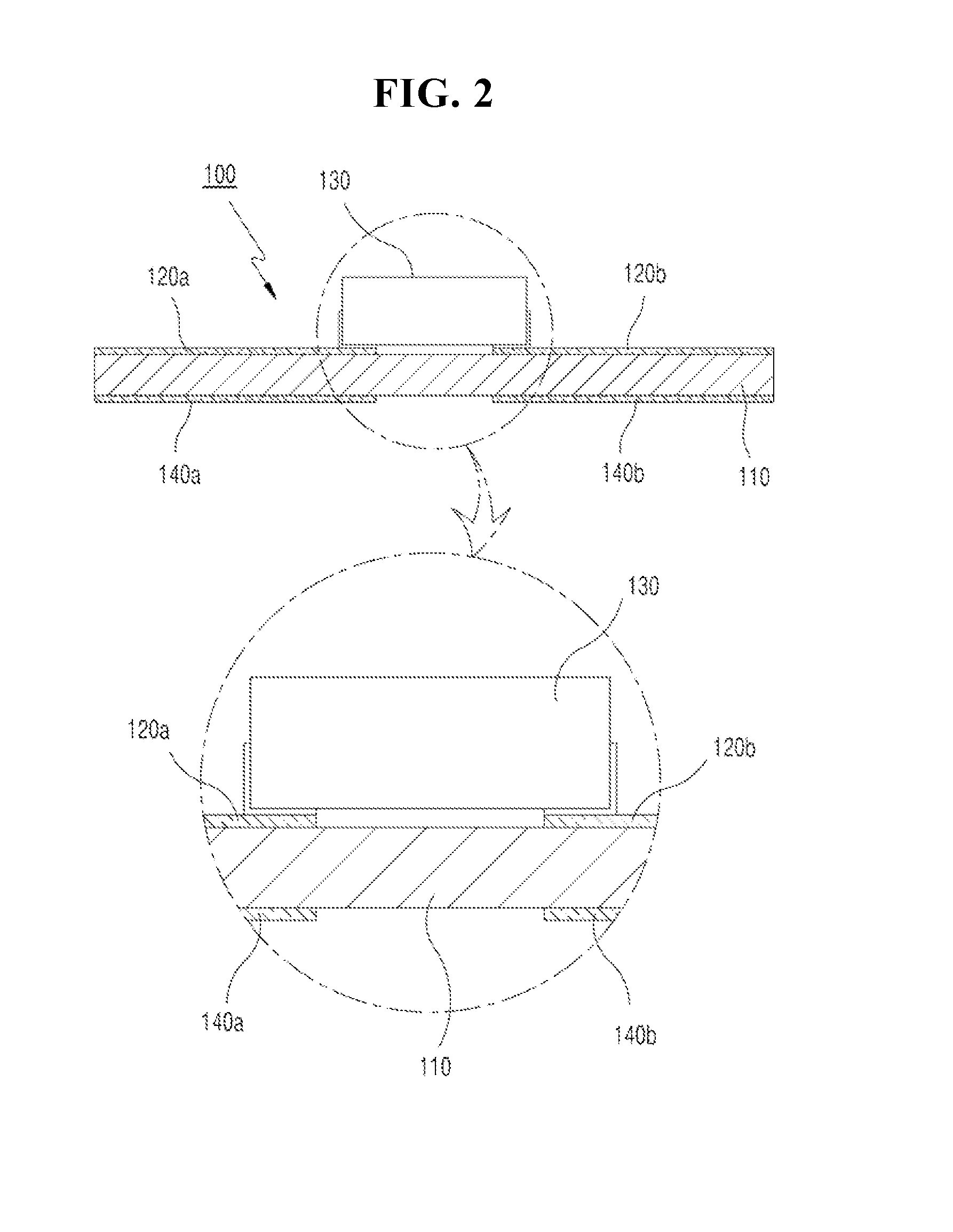Wireless identification tag, electronic product PCB having same, and system for managing electronic products
- Summary
- Abstract
- Description
- Claims
- Application Information
AI Technical Summary
Benefits of technology
Problems solved by technology
Method used
Image
Examples
first embodiment
[0051]Referring to FIG. 1 and FIG. 2 in the accompanying drawings, a wireless identification or RFID tag 100 according to the invention includes an insulating means 110, upper terminals 120a and 120b, a tag chip 130 and lower terminals 140a and 140b.
[0052]The insulating means 110 may be understood as a dielectric medium that has a preset level of permittivity (∈). The insulating means 110 can be made of a variety of materials, such as plastic, paper, or ceramic, with the permittivity being variable depending on the material and thickness.
[0053]In FIG. 3A is a view showing the upper surface (upper portion) of the RFID tag 100 shown in FIG. 1, and FIG. 3B is a view showing the lower surface (bottom) of the RFID tag 100 shown in FIG. 1. A pair of the upper terminals 120a and 120b is provided on the upper surface of the insulating means 110, spaced apart from each other. The tag chip 130 is connected to the upper terminals 120a and 120b. The tag chip 130 has a pair of terminals 132a an...
second embodiment
[0058]A description will be given below of the RFID tag according to the invention.
[0059]The RFID tag according to the second embodiment is designated with reference numeral “200” in FIG. 6 to FIG. 8. The RFID tag 200 indicates a surface-mount device (SMD) produced by standardizing the RFID tag 100 according to the first embodiment through surface mounting. For reference, of course, the RFID tag 100 according to the first embodiment also corresponds to a surface-mounting type.
[0060]Specifically, referring to FIG. 6, the RFID tag 200 includes a tag chip 210 which has defined therein inner terminals 212a and 212b, an insulating body 220 which contains the tag chip 210 therein, and a pair of outer terminals 230a and 230b which are provided on the outer portions of the insulating body so as to face the inner terminals 212a and 212b.
[0061]Although the insulating body 220 can be made of the materials of the insulating body 110 according to the first embodiment, the present invention is n...
third embodiment
[0066]FIG. 9 and FIG. 10 are views illustrating an electronic product PCB 10 according to the invention.
[0067]Referring to the figures, a first isolating pad 16a and a second isolating pad 16b are provided on the upper surface of the electronic product PCB 10 such that the first and second isolating pads 16a and 16b are spaced apart from each other at a preset distance. Herein, the term “isolating” indicates the state in which each of the pads 16a and 16b is not physically connected to any pattern (the power pattern, ground pattern or signal pattern) formed on the electronic product PCB. A tag chip 18 is connected to the isolating pads 16a and 16b.
[0068]First and second lower pads 12a and 14b are provided on the lower surface of the electronic product PCB 10. The first lower pad 12a extends from the first pattern 12 so as to face the first isolating pad 16a, and the second lower pad 14b extends from the second pattern 14 so as to face the second isolating pad 16b. Preferably, the f...
PUM
 Login to View More
Login to View More Abstract
Description
Claims
Application Information
 Login to View More
Login to View More - R&D
- Intellectual Property
- Life Sciences
- Materials
- Tech Scout
- Unparalleled Data Quality
- Higher Quality Content
- 60% Fewer Hallucinations
Browse by: Latest US Patents, China's latest patents, Technical Efficacy Thesaurus, Application Domain, Technology Topic, Popular Technical Reports.
© 2025 PatSnap. All rights reserved.Legal|Privacy policy|Modern Slavery Act Transparency Statement|Sitemap|About US| Contact US: help@patsnap.com



